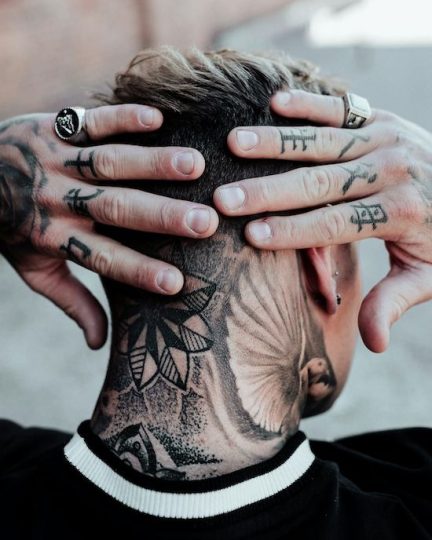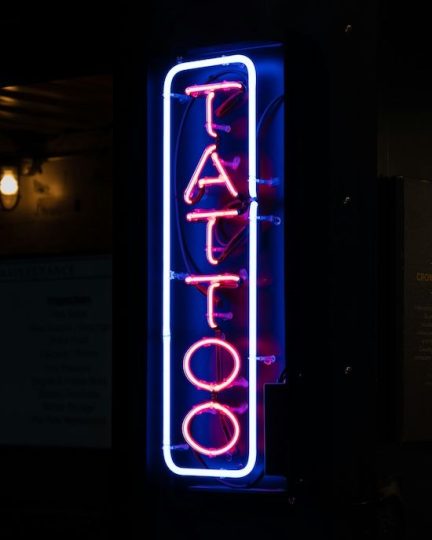When you’re thinking about tattoo art, there’s a lot to consider: placement, size, color, and even the image itself. But interestingly, most of us fail to acknowledge another fundamental issue: copyright infringement. It may not feel as glamorous, but copyright laws are actually enacted in various ways when tattooing new work. From the artist behind an original design being tattooed by another to tattoo artists inking their own work—and even fine artists using tattoo art as inspiration—we’ll take a look at four hypothetical scenarios to better understand who owns the copyright when it comes to tattoos:
- You’re proud of your family heritage and want to honor them with a tattoo of your family crest. But, you want to make some special alterations to the design to make it a little more unique, so you opt to swap out a few historical symbols and replace them with drawings of your own. Since the design is straightforward and relatively standard, you visit a local tattoo parlor to have the work done.
- You discovered a sensational tattoo artist on social media and have been following them for quite some time. After seeing a few examples that really wowed you, you reach out to the artist for a consultation. They let you know that the designs are all their own, and that they have a policy against tattooing the same work twice. However, you can give them some inspiration to work with, like a particular animal or song lyric, and they’ll create something entirely unique and just for you.
- You’re a popular painter and one of your works has garnered a lot of attention and gone viral. Suddenly, you start to see that the image has been reproduced as a tattoo—which is kind of cool, but a little unsettling. No one has bought the rights to your piece while tattoo artists are currently making money off your design.
- You’re a street style photographer and absolutely enamored by complex tattoo art. You encounter plenty of folks that are willing to model and sign a waiver, and you make sure that they fully understand that the copyright of their portraits belongs to you. Your images take off, and you land an exhibition—which becomes wildly successful and your work sells like hotcakes. But soon, you receive a note from a tattoo artist alleging that the tattoos in your images are their intellectual property, and you’re now liable for copyright infringement. The tattoo artist asks for compensation.
Tattoo Art is actually one of the more complicated copyright scenarios that one might encounter: in fact, you have a greater chance of running into copyright issues when your own flesh is the canvas. Let’s discuss the ins and outs of these unique scenarios and provide a definitive guide to protecting your work against copyright infringement.

Decorative tattoo art isn’t just a look: it’s intellectual property.
Licensing and Tattoo Art
In the United States, copyright law protects original works by assigning certain “protections”, or rights, to creators. The caveat? In order for something to be copyright protected, the original work must be fixed to a tangible medium. It may sound bizarre, but fixing an original drawing to the skin actually qualifies—assuming there is a degree of creativity employed, making it an original design (a simple and straightforward heart, for example, likely wouldn’t be copyright protected).
Most tattoo artists are using original designs for their tattoo art, in which case the tattoos themselves would be protected under copyright law. Interestingly, the copyright owner—meaning the tattoo artist—holds the rights to the work, which translates into a right to make copies, distribute, display, publicly perform, and otherwise make derivatives of the original tattoo art.
Copyright owners also have the right to license and/or transfer these rights to other parties. Most legal experts would agree that tattoo art comes with an implied license to display the work. However, the right to display your tattoo does not allow you to reproduce the original artwork, which means you can still be liable for copyright infringement should you create derivatives of the tattoo artist’s design.
It may sound strange, the idea that someone could have ownership over a part of your own body. However, when it comes to copyright, it’s an important and fascinating distinction that can protect you from unnecessary legal woes.
Understanding different tattoo art scenarios
Think back to our original example in which a client makes subtle changes to a preexisting design: it’s surprisingly complex. The new design was created by the client instead of the artist, theoretically giving them authorship. However, copyright law allows more than one person to own a work—and the tattoo artist, having inked the piece itself, also has the right to copyright protection.
This complicated scenario can be mitigated through contracts, like a work-for-hire agreement, which allows someone other than the original creator to be considered the author of the work. These contracts are options when a work has been:
- Prepared within the scope of employment; or
- Specially ordered or commissioned for use as a contribution to a collective work (like a movie), translation, supplementary work, compilation, instructional text, test, or an atlas.
The important thing here is that a work-for-hire agreement requires a written contract. So, if this is a protection that’s important to you, you’ll need to ask your artist to agree and sign.
Let’s now turn our attention to the second example, which also features a collaborative element. You provided feedback and guidance which the tattoo artist then used to create an original design. Could this also constitute a work-for-hire scenario?
Interestingly, the answer is no, since the artist’s designs are still entirely their own. While you could always certainly ask about a contract, it’s unlikely that they’d want to sign away the copyright to something that is ultimately their creative output.

Even at the tattoo parlor, copyright law can be tricky.
Issues facing artists that reference or capture tattoo art
It may seem unusual, but fine artists also need to be aware of issues that can arise when their own work involves tattoo art. You’ll recall our earlier scenario, in which a painter was frustrated to learn that their work was being tattooed on various people without compensation.
The painter is unequivocally the original creator of the work, but are they required to share their copyright with the tattoo artist? The answer is no: in fact, the tattoo artist is actively copying the work of another creative, therefore infringing upon a protected design. It’s a slippery slope: as creators themselves, tattoo artists should be cautious about the origins of a design when tattooing art that’s been supplied by a client. It may seem melodramatic, but being careless in this instance could actually result in future legal woes.
Our street photographer also faces some interesting copyright considerations, especially since they didn’t realize that the tattoos they’d photographed were someone else’s intellectual property. It may seem far fetched, but there is an infamous case in which this actually transpired: in 2011, the tattoo artist behind Mike Tyson’s prominent face tattoo took Warner Bros. to court for referencing (and replicating) their original design for a hit movie. The court was reluctant to conclude that the studio hadn’t infringed on the tattoo artist’s copyright, and both parties wound up resolving the case amicably.
How to protect tattoo art from copyright infringement
Did you know that copyright protection exists from the moment something’s been created—including tattoo art? But while this may encourage you to rest easy, it’s never a bad idea for tattoo artists (and artists from every stroke) to register for a copyright, especially if your style is recognizable and frequently employs the same motifs, patterns, or techniques.
Tattoo artists can also protect their original designs from copyright infringement by requiring clients to sign a contract. It’s imperative, however, that they do their due diligence before getting to work and develop a thorough understanding of the origins of the design. Similarly, clients that provide their own tattoo art might want to consider having a deliberate conversation with their tattoo artist about the rights they’d like to retain in order to determine whether or not a work for hire situation is possible. At the end of the day, you just want to ensure that both parties are on the same page. Copyright ultimately extends beyond traditional mediums, and regardless of whether it’s asserted on the canvas or on the skin, the artist has a right to retain authorship over their creative work.
What do you think about copyright protections and tattoo art? How would you respond to a request to use your design for a tattoo? Let us know in the comments.
